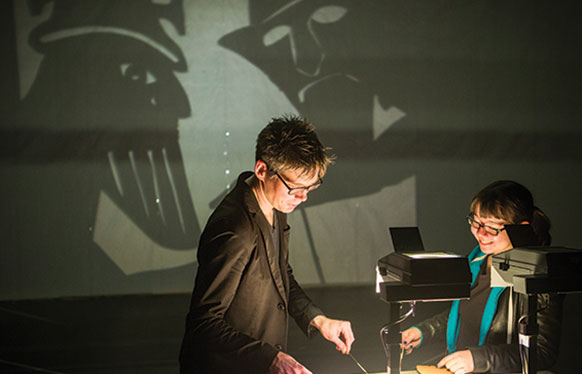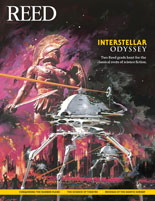
IRIS login | Reed College home Volume 94, No. 1: March 2015
The Science of Theatre

Prof. Ksander and Marisa Kanai ’15 work on shadow theatre performance of Gilgamesh for Theatre 396, Puppetry and Performing Objects. Photo by Leah Nash
Prof. Peter Ksander uses the stage as a laboratory
By Randall S. Barton
If Friar Laurence had been able to communicate via cell phone instead of by letter, his message might have reached Romeo in time to explain the truth about Juliet and stop him from drinking the cup of poison. Technology has the power to shape—and reshape—drama.
“The glowing rectangles we live with are changing our relationships,” says Prof. Peter Ksander [theatre 2011–]. “Theatre mirrors our life.”
Technology played a role in Ksander’s winning an award in October for outstanding visual design at the Bessie Awards in New York. He shared the award with the video designer, the lighting designer, the costume designer, and the interactive technology designer on the New York production This Was the End, which stars four actors in their 60s trying to alter the outcome of Chekhov’s play Uncle Vanya.
The Bessies recognize exceptional work in dance and performance and singled out this production for “a theatre set seamlessly doubled by video projections, echoing the role of memory with its odd tricks and resurrections.”
Prof. Ksander built the set from a wall with cabinets salvaged from a New York public school. Actors were videotaped in and around the wall and that footage was projected directly onto the matching set during live performances, forming ghost images of the characters opening cabinets and running around the wall.
Ksander has loved creating imaginary worlds since he was a boy playing with Star Wars action figures. By the time he was studying for an MFA at the California Institute of the Arts, he realized that his interests in science, history, cartography, art, carpentry, and building codes could be fused into a single discipline—theatre.
He developed his practice in New York City, working first as a freelance designer, primarily in experimental downtown theatre. He designed sets and lighting for the National Theatre of Hungary, the Walker Art Center, Portland’s Time-Based Art Festival, the Public Theater, and the Brooklyn Academy of Music. In 2008 he won an Obie award for the scenic design of Untitled Mars (this title may change). He also served as a curator for the Ontological-Hysteric Theater and the Incubator Arts Project, and has had continuing artistic relationships with the Theatre of a Two-Headed Calf, TENT, Stillpoint Productions, Restless NYC, and Banana Bag and Bodice.
While working with the Ontological-Hysteric Theater in New York, he noticed a T-shirt the stage manager, Brendan Regimbal ’04, was wearing.
“What’s Renn Fayre?” he asked, eyeing the shirt. Reed College had come onto his radar. Some time later when Peter decided to teach theatre, he spied an opening for a job at Reed. “That’s the place where Brendan went,” he said to himself. “That’s a place I could be.”
![]()
As a teacher at Reed, Ksander finds theatre is an excellent laboratory for the investigation of hypotheses. What does it mean to be a human in a particular time or situation? How do we inhabit space and time?
“Experimental theatre is not a style and has nothing to do with content,” he explains. “It’s more of a process borrowed from the sciences. What are the effects of putting walls in a certain configuration and what does that do to your experience? We use the methodology of experiment—hypothesis, test, and analyze results. Did it work? Did it not work?”
One of Ksander’s main interests is history. While historians typically focus on sweeping political, social, and economic trends, theatre looks at the moments when things change.
“Theatre looks at potentials, what might have been, and how tenuous every moment in history is,” he says. “Huge events often hinge on small things.”
He cites the unhappy accident of the Archduke Franz Ferdinand’s escaping one assassination attempt only to have his driver take a wrong turn. The car came to a stop in front of Gavrilo Princip, a tubercular revolutionary, who shot the archduke and his wife at point-blank range, triggering the First World War.
Designing a set is creating a crucible for a performance, Ksander says, in the sense that it is a chamber that amplifies the heat and reflects it inward.
“I try to create the conditions that amp up and intensify the performances,” he says. “You can’t get out of this container and the heat is going up and up and up.”
Ksander teaches intro theatre, stage design, lighting design, and combining performance with technology. In his conference-lab classes, students investigate theories and methods used to represent designs.
“Writing a paper is not the most efficient way to convey your design ideas,” Ksander explains. “I have to teach tools such as drafting, collage work, and model building—paper projects, we call them.”
Last fall he taught a course in visual performance narratives—how to create a narrative without dialogue.
“Peter always reminds us that we don’t have to communicate solely with words,” says Rennie Meyers ’15. “Visual narratives can evoke responses in a new, dynamic way. It’s a welcome reprieve from the written word.”
Last year Ksander cotaught a class in which students used shadow puppets to perform the Epic of Gilgamesh.
“Shadow puppetry combines all kinds of different things I’m interested in,” Peter says. “It meshes both lighting and set design. Things that are difficult to express on stage—such as scale and things that are epic—are easy in shadow puppetry. Changes of location can be instantaneous in light and shadow.”
Making theatre has traditionally required that participants come together in the same room. Ksander is interested in reframing his practice so that “being in the room” might be accomplished in new ways.
For instance, instead of beginning with a script and designing a space to enclose it, he proposes a production that might begin with designing the space and then figuring out, “What happens in it?” He is currently collaborating on a project where artists work independently on the text, movement score, and object score, and then layer them together.
Experimental? Definitely. But theatre is at its core an experimental enterprise, each performance a unique slice of time, space, and witnesses. “You can draw a circle around it, say 7:30 on Thursday night in this place,” Ksander says. “Those moments in time and space will never be the same again. The next night we’ll attempt to do it again, but it will be the next night.”
After all, theatre may be a kind of science, but it is not an exact science.

LATEST COMMENTS
steve-jobs-1976 I knew Steve Jobs when he was on the second floor of Quincy. (Fall...
Utnapishtim - 2 weeks ago
Prof. Mason Drukman [political science 1964–70] This is gold, pure gold. God bless, Prof. Drukman.
puredog - 1 month ago
virginia-davis-1965 Such a good friend & compatriot in the day of Satyricon...
czarchasm - 4 months ago
John Peara Baba 1990 John died of a broken heart from losing his mom and then his...
kodachrome - 7 months ago
Carol Sawyer 1962 Who wrote this obit? I'm writing something about Carol Sawyer...
MsLaurie Pepper - 8 months ago
William W. Wissman MAT 1969 ...and THREE sisters. Sabra, the oldest, Mary, the middle, and...
riclf - 10 months ago